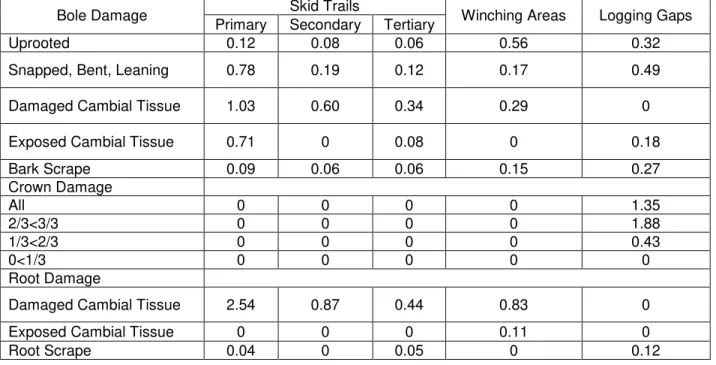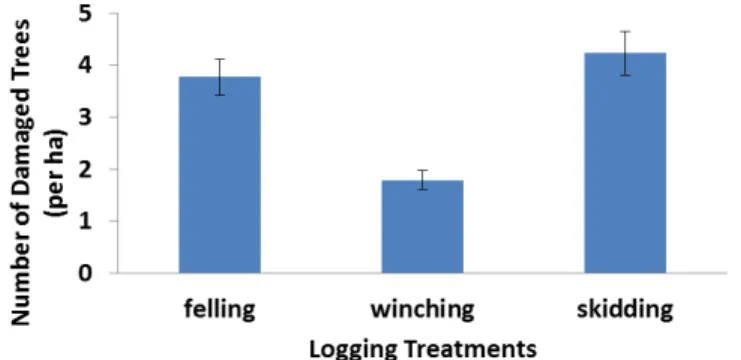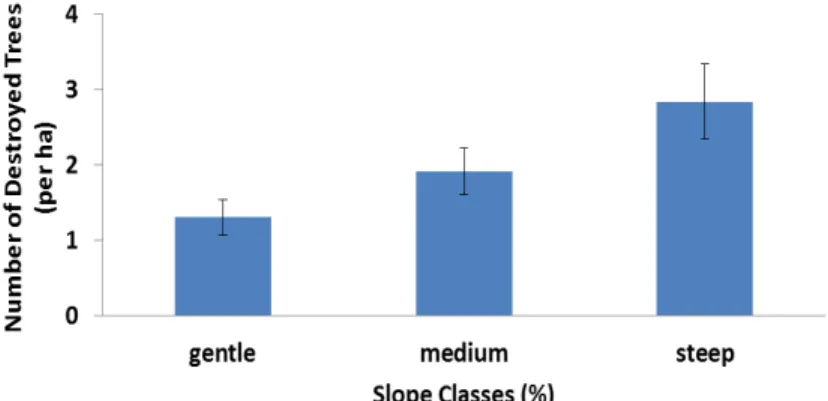PEER-REVIEWED ARTICLE
bioresources.com
SELECTIVE LOGGING AND DAMAGE TO UNHARVESTED
TREES IN A HYRCANIAN FOREST OF IRAN
Farshad Keivan Behjou and Omid Ghafarzade Mollabashi*
Selective logging in mature hardwood stands of Caspian forests often causes physical damage to residual trees through felling and skidding operations, resulting in a decline in bole quality and subsequent loss of tree value. This study evaluated the logging damage to residual trees following logging operations. A total density of 5.1 trees/ha and 17.3 m3/ha of wood were harvested. On average, 9.8 trees were damaged for every tree extracted, including 8 trees destroyed or severely damaged. The most common types of damage included uprooted stems, stem wounds to the cambial layer, and bark scrapes. Damage to trees sustained along skid trails was found to be significantly more than the damage that incurred within logging gaps and winching areas. The results of this study suggest that logging practices also need to be accompanied by close supervision of field personnel and post-logging site inspections to be implemented properly.
Key words: Selective logging; Logging damage; Skid-trails; Logging gaps
Contact information: Department of Range and Watershed Management, Faculty of Agriculture Technology and Natural Resources, University of Mohaghegh Ardabili, Ardabil, Iran;
* Corresponding author: omid_ghafarzade@yahoo.com
INTRODUCTION
PEER-REVIEWED ARTICLE
bioresources.com
development of forest management plans that seek sustainable timber harvesting on all of
Iran’s permanent production forestlands (Marvie Mohajer 2007). Today, Iranian forest
management plans are based on removal of isolated mature trees on a sustained yield basis with the goal of improving the overall commercial value of the forest (Marvie Mohajer 2007). Despite noteworthy advances, damage to future crop trees during selective logging is thought to be one of the largest silvicultural challenges facing sustainable forest management in the region (Nikooy et al. 2010).
The importance of damage in the course of logging has been illustrated in the literature. It has been found that the occurrence of logging wounds is dependent on the harvest operation (Nyland and Gabriel 1971; Reisinger and Pope 1991). Smith et al. (1994) showed that sapwood wounds pose no immediate threat to the tree but increase the likelihood of attack by insects or diseases. Timber extraction, measured as the number of harvested trees per hectare might additionally have consequences for a number of forest functions, including biodiversity maintenance, carbon sequestration, and the production of subsequent timber crops, as shown by Panifil and Gullison (1998) in Bolivia. Logging damage to the residual trees is a consequence of any harvesting activity. In addition, Fajvan et al. (2002) claimed that minimizing the damage to residual trees is critically important for the maintenance of stand vigor and timber quality during skidding operations. Froese and Han (2006) observed that the frequency and extent of decay depend on the area, width, depth, and location of the wound, as well as on tree species, age, and vigor. Marvie Mohajer (2007) indicated that a critical step toward sustainable forestry in the region is the monitoring of the quality of residual trees following logging. Naghdi (2006) and Nikooy et al. (2010) considered the levels of residual tree damage in selection-managed stands and observed that 25% to 35% of the residual trees had been injured at some point in the course of logging. Similar researches have been carried out in tropical forests. Jackson et al. 2002 indicated that on average 44 trees were damaged for every tree extracted including 22 trees killed or severely damaged, six of them commercial species. Krueger (2004) showed that pre-harvest skidtrail planning and improved timber felling techniques yield short-term financial gains relative to conventional management. Holmes et al. (2002) indicated that reduced impact logging is less costly and more profitable than conventional logging under the conditions observed at the eastern Amazon study site. Panfil and Gullison (1998) indicated that both harvest intensity and total mortality were quadratic increasing functions of harvest intensity when expressed in terms of basal area. The main objective of this study was to evaluate the damage to residual trees resulting from selective logging.
EXPERIMENTAL
Site Description
PEER-REVIEWED ARTICLE
bioresources.com
were northwestern and northern. The total production volume was 2699 m3, and the skidding was done from the stump area to the roadside landing with a ground-based skidding system. Beech (Fagus orientalis); horn beam (Carpinus betulus); maple (Acer
velutinum), alder (Alnus subcordata), and elm (Ulmus glabra) are dominant canopy
species.
Residual Tree Damage
The stands were harvested via manual felling with a chainsaw and semi-mechanized harvesting system with a rubber tired skidder throughout a 6-month period from the winter of 2010 to the spring of 2011. The chainsaw operator had 10 years of experience, whereas the skidder operator had 8 years. On our 152 hectare study site, data were collected after selective logging from the remaining trees to evaluate the amount of damage to residual trees. Damage to the residual trees was recorded according to the cause of damage (i.e. felling, winching, and skidding) and the location and severity of the wound.
Table1. Classification of Damages to Residual Trees along Skid Trails and Logging Gaps (modified from Krueger 2004)
Damage Type Bole Root Crown
Severe Snapped at Base, Bent, Or Severely Leaning
Uprooted Loss of Entire Crown, Less Than Entire But More Than Two-Thirds of Crown
Moderate Exposed And Damage Cambial Tissue
Exposed and damaged cambial tissue
Loss of less than two-Thirds But More Than one-Third of Crown
Minor Exposed Cambial Tissue But No Damage, Bark Scrape
Exposed Cambial Tissue But No Damage, Root Scrape
Loss of Less Than One-Third of Crown
Assessing Tree Damage Associated with Felling Operations
Approximately 30 single tree fall sites were randomly selected in the region, and the tree damages incurred in each parcel were tallied. The damages to the residual trees were recorded according to the location and severity of the wound (Krueger 2004).
Assessment of Tree Damage Associated with Skidding Operations
PEER-REVIEWED ARTICLE
bioresources.com
Experimental Design and Statistical Analysis
There was interest not only in quantifying the damage rooted from selective logging. The cause of damage was quantified and compared, too. A factorial experiment based on randomized block sampling was used in this study; the parcels were blocks and harvesting treatment (felling, winching, and skidding) and slope (0 to 20, 20 to 40, and >40%) were factors. Analysis of variance and Duncan multiple tests were employed to test the differences in residual tree damage among different logging operations and different slope classes within the forest.
RESULTS AND DISCUSSION
Statistical Analysis of Damage to Residual Trees
The total number of trees damaged per tree harvested, when tabulated according to damage classification and the cause of damage, showed that the most common types of damage to residual trees had happened in winching areas and skid trails. Types of damage included uprooted stems and damaged cambial tissue, while the most common types of damage to residual trees in logging gaps included crown damage (Table 1). Statistical analysis showed that for consideration of all damaged trees, skid trails and logging gaps accounted for a significantly greater number of damaged unharvested trees per tree harvested in comparison to winching areas (Tables 3, 4, and Fig. 1). On the other hand, the numbers of destroyed trees per one harvested tree were significantly different among logging treatments (Tables 3 and Fig 2).
Table 2. Total Number of Trees Damaged per Tree Harvested by Damage Classification and Cause of Damage
Bole Damage Skid Trails Winching Areas Logging Gaps
Primary Secondary Tertiary
Uprooted 0.12 0.08 0.06 0.56 0.32
Snapped, Bent, Leaning 0.78 0.19 0.12 0.17 0.49
Damaged Cambial Tissue 1.03 0.60 0.34 0.29 0
Exposed Cambial Tissue 0.71 0 0.08 0 0.18
Bark Scrape 0.09 0.06 0.06 0.15 0.27
Crown Damage
All 0 0 0 0 1.35
2/3<3/3 0 0 0 0 1.88
1/3<2/3 0 0 0 0 0.43
0<1/3 0 0 0 0 0
Root Damage
Damaged Cambial Tissue 2.54 0.87 0.44 0.83 0
Exposed Cambial Tissue 0 0 0 0.11 0
PEER-REVIEWED ARTICLE
bioresources.com
Table 3. Analysis of Variance (P values) of the Effect of Parcels, Logging Treatments, and Slope Classes on Residual Trees
Variable Parcels
(2 d.f.)
Logging Treatments (2 d.f.)
Slope Classes (2 d.f.)
Logging Treatments *Slope Classes (4 d.f.)
Number of Damaged Trees
Number of Destroyed Trees
0.075
0.849
0.000**
0.000**
0.002**
0.000**
0.699
0.010*
*
P<0.05
**
P<0.01
Results showed that logging gaps had a significantly greater number of destroyed trees per tree harvested than skid trails and winching area (Tables 3, 4). In addition, statistical analysis showed that steep slope class experienced significantly greater number of damaged trees per harvested tree compared to medium and gentle class (Tables 2, 3, and Fig. 3). Besides, the numbers of destroyed trees per one harvested tree were significantly different among slope classes (Tables 2, 3, and Fig. 4).
Fig 1. Number of damaged residual trees in different logging treatments
PEER-REVIEWED ARTICLE
bioresources.com
Fig 3. Number of damaged residual trees in different slopeclasses
Fig 4. Number of destroyed residual trees in different slope classes
Comparison among logging gaps, winching areas, and skid trails revealed that although more trees were damaged along skid trails (Fig 1), fewer trees were destroyed along skid trails. On the contrary, in felling areas, almost all trees that had been damaged, were judged to be on their way to destruction (Figs. 1 and 2). The results of this study showed that one of the potential difficulties of selective cutting in any stand is logging damage to residual trees that can result in reduction of the tree wood value. Absolutely, much of this damage could be avoided through more careful logging procedures. The results indicated that most of the instances of bole damage were caused by skidding, during which tree-length logs scraped against the boles of standing trees on primary and secondary skid trails, but most of the crown damage occurred as a result of felling operations; so, better felling procedures, such as directional felling, could inhibit some of the crown damage.
PEER-REVIEWED ARTICLE
bioresources.com
will not heal over nor increase to a better log grade in a foreseeable future. The logging wounds provide opportunities for fungi to enter and rot the trees, eventually diminishing their value (Shigo 1979; 1986). The results showed that logging treatments and slope gradient had significant impact on residual trees (P = 0.000) following logging operations.
CONCLUSIONS
1. More careful logging would have reduced the amount of residual stem damage associated with selective logging in Caspian forests.
2. The unplanned logging operations increased the chance of bole and crown damage to residual trees.
3. Preserving the quality of residual trees during selective logging is necessary to achieve sustainable forest management in Caspian forests.
4. Selective logging has many potential advantages, including reducing stand density, favoring certain species, increasing diameter growth, and having more pleasing aesthetics compared to clear-cutting. However, the potential detrimental effect, due to damage to residual trees should be considered in selective logging.
REFERENCES CITED
Andreassen, K. (1994). “Development and yield in selection forest,” Medd. Skogforsk
47(5), 1-37.
Fajvan, M. A., Knipling, K. E., and Tift, B. D. (2002). “Damage to Appalachian
hardwoods from diameter-limit harvesting and shelterwood establishment cutting,”
North J. Appl. For. 19, 80-87.
Froese, K., and Han, H. S. (2006). “Residual stand damage from cut-to-length thinning of
a mixed conifer stand in northern Idaho,” Western Journal of Applied Forestry 21(3),
142-148.
Holmes, T. P., Blat. M. G., Zweede, J. C., Pereira Jr., R., Barreto, P., Boltz, F., and Bauch, R. (2002). “Financial and ecological indicators of reduced impact logging Performance in the eastern Amazon,” Forest Ecology and Management 163 (1-3), 93-110.
Jackson, S. M., Fredricksen, T. S., and Malcolm, J. R. (2002). “Area disturbed and
residual stand damage following logging in a Bolivian tropical forest,” Forest ecology
and management 166, 271-283.
Krueger, W. (2004). “Effects of future crop tree flagging and skid trail planning on conventional diameter limit logging in a Bolivian tropical forest,” Forest Ecology
and Management 188, 381- 393.
Larsen, J.B. (1997). “Shovbruget ved en skillevej-teknologisk rationalisering eller
biologisk optimering?” In: Dansk Skovbrug i 100 år, festskrift udgivet i anledning af
PEER-REVIEWED ARTICLE
bioresources.com
Lexerod, N. L., and Eid, T. (2006). “Assessing suitability for selective cutting using astand level index,” Forest Ecology and Management 237, 503-512.
Lundqvist, L. (1989). “Use of the selection system in Norway spruce forests—changes in
stand structure, volume increment, in growth and regeneration on experimental plots managed with single-tree selection,” Doctor Scientarum Thesis, Department of Silviculture, Swedish University of Agricultural Sciences, Umeå.
Marvie Mohajer, M. R. (2007). Silviculture, University of Tehran Tehran University, Tehran. (In Persian)
Naghdi, R. (2006). “Investigation and comparison of two harvesting systems: Tree length
and cut-to-length method in order to optimize road network planning in Neka, Iran,” Ph.D thesis, Tarbiat Modares University, Tehran. (In Persian).
Nikooy, M., Rashidi, R., and Kocheki, G. (2010). “Residual trees injury after selective
cutting in broadleaf forest in Shafaroud,” Caspian J. Env. Sci 8(2)173-179.
Nyland, R. D., and Gabriel, W. J. (1971). “Logging damage to partially cut hardwood stands in New York State,” Applied Forestry Research Institute, State University
College of Forestry, 5(1).
Panfil, S. N., and Gullison, R. E. (1998). “Short term impacts of experimental timber harvest intensity on forest structure and composition in the Chimanes Forest,
Bolivia,” Forest Ecology and Management 102, 235-243.
Reisinger, T. W., and Pope, P. E. (1991). “Impact of timber harvesting on residual trees
in a central hardwood forest in Indiana,” USDA For. Serv. Gen. Tech. Rep. 148.
Shigo, A. L. (1979). “Tree decay: An expanded concept,” Agricultural Information
Bulletin 419. Washington, DC: U.S. Department of Agriculture, Forest Service.
Shigo, A. L. (1986). “New tree biology: facts, photos and philosophies on trees and their
problems and proper care,” Durham, NH: Shigo and Trees, Associates.
Smith, H. C., Miller, G. W., and Schuler, T. M. (1994). “Closure of logging wounds after
10 years,” USDA For. Serv. Res. Pap., 5 Radnor, PA, NE-692.
Tarp, P., Helles, F., Holten-Andersen, P., Larsen, J. B., and Strange, N. (2000).
“Modelling near-natural silvicultural regimes for beech – An economic sensitivity analysis,” For. Ecol. Manage. 30, 187-198.


